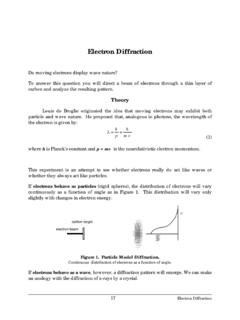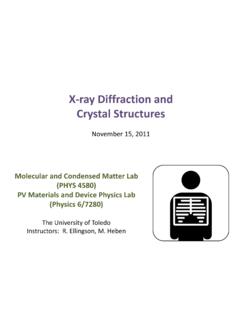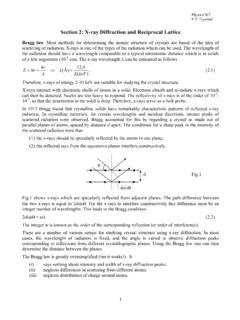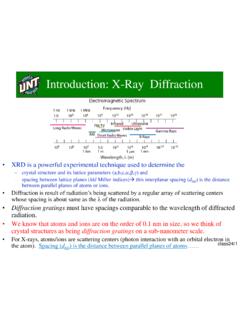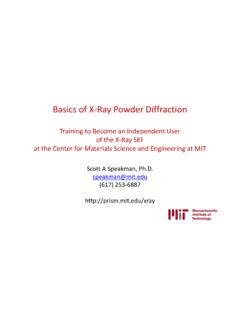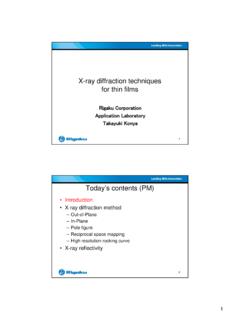Transcription of EXPERIMENT 1 DEMONSTRATION OF X-RAY DIFFRACTION
1 EXPERIMENT 1 DEMONSTRATION OF X-RAY DIFFRACTION The activities in this laboratory EXPERIMENT involve observation, analysis and evaluation. The activities are designed so that students should complete the lab and calculations in class. Objective To observe one method of evaluating atomic crystalline structure by using X-RAY DIFFRACTION . To understand the use of Bragg's Law and its relation to crystal structure. Introduction X-RAY DIFFRACTION can be used to determine a materials crystalline structure and lattice parameter. This information can then be used to identify the material being analyzed since each metallic element in the periodic table has a unique combination of lattice structure and parameter at room temperature.
2 When an X-RAY beam is directed at a metallic crystal the beam hits the atoms and produces two types of x-rays, white x-rays and characteristic x-rays. White x-rays include a wide range of wavelengths and are not of interest in this EXPERIMENT . Characteristic x-rays are caused by the ejection of an electron from an inner shell of an atom hit by the incident X-RAY . When an outer shell electron moves to fill the space created in the inner shell, energy in the form of an X-RAY photon is emitted. Bragg's law is used to determine a crystal parameters from its characteristic X-RAY pattern. The x-rays that strike a crystal have a wavelength of about the same length as the space between atoms in the crystal lattice.
3 Bragg's law can be derived by considering a cubic crystal lattice that consists of parallel planes of atoms. If each plane is assumed to act as a surface which is struck by the incident X-RAY beam we see the beam reflected in some cases and not reflected in others. In the case of reflection it is seen that the beams exiting the crystal are in phase and act to reinforce each other. This occurs when the incident beam hits the parallel planes at certain angles known as Bragg Angles, In the nonreflecting case, the waves leaving the crystal are out of phase and cancel each other. Non-reflectance occurs when the incident beam strikes at arbitrary angles.
4 Each case is illustrated in Figure 1. Figure 1 - The reflection of x-rays in the (hkl) planes of a crystal. (Guy & Hren) If one examines the geometry of the reflected beam the relationship between Bragg's angle, the wavelength of the X-RAY , , and the interplanar spacing, d, can be found. Figure 2 shows arbitrary planes of atoms whose indices are (hkl) and which have interplanar spacing d. If the x-rays entering the crystal are in phase at OM and those reflected are in phase at ON then the distance along MPN must equal an integral number of wavelengths, n . The geometry shows that MP=PN and that each of these equals dsin.
5 Therefore for reflected X-RAY beams: sin2dn (This is Bragg's Law) (1) where n= l,2,3,.. For our purposes we assume n=l. In the powder method of X-RAY DIFFRACTION the material to be analyzed is placed in the camera that is sketched in Figure 3. The specimen sits in the center of the camera with the film located in a circle around it. When a monochromatic X-RAY beam is directed at the specimen DIFFRACTION takes place and characteristic x-rays are emitted in conical sections that intersect and expose the film at different arcs. When the film is flattened out these arcs are seen as lines as shown in Figure 4.
6 The distance between the beam exit and entrance on the X-RAY film corresponds to a Bragg angle of 90o. The Bragg angle of each characteristic line on the film can then be found by using the following ratio: niniSS (2) where iS is the distance from the exit to the line of interest, nS is the distance from the exit to the entrance, 90o is the Bragg angle from exit to entrance, and is the Bragg angle of the line in question. Once all the Bragg angles have been found it is possible to determine the crystalline structure of the sample by considering the geometry of the crystal.
7 For pure metals in a cubic structure: 222lkhadhkl (3) where dhkl is the interplanar spacing between (hkl) planes, a is the lattice parameter, and h,k,l are Miller indices of the planes. Substituting eqn. (3) into Bragg's law eqn. (l) gives: 222sin2lkha (4) Letting 2222lkhQ , we can rewrite eqn. (4) as: 2222sin4Qa (5) or 2222sin4 aQ (6) since 224a is a constant we can say: 22sin CQ (7) Eqn. (7) states that the squares of the sines of the angles that result in a DIFFRACTION peak (line on the film) occur in a certain ratio of whole numbers. This is due to the structure factor of the lattice.
8 We can use these ratios to determine the crystal lattice structure. The lines shown in Figure 5 correspond to the planes which diffract x-rays for cubic lattice structures. Once the crystalline structure has been found the lattices parameter can be found by remembering that: 224a constant (8) which becomes: Ca2 (9) From eqn. (7) we see that the constant is equal to: 22sinQC (10) Knowing ao and the lattice structure we can then find the corresponding metal on the attached table of crystal structures. Procedure You will do this EXPERIMENT in two parts. In the first part you will be provided data and asked to determine the crystal structure and lattice parameter that will allow you to identify the material.
9 In the second part you will be shown a strip of film from the CSUN DIFFRACTION camera. Using the film you will determine the Bragg Angles, Crystalline structure and lattice parameter. Part l - During a lunar exploration an unknown metallic crystalline substance is discovered whose external morphology indicates that it is a cubic material. A DIFFRACTION pattern of this material, using radiation of wavelength , provides the following data: DIFFRACTION peak # Bragg DIFFRACTION angle,i iSin iSin 2 122 SinSini Q2 C a #l #2 #3 #4 #5 l.
10 Construct a table similar to the one shown above. 2. Using the given DIFFRACTION data calculate sin and 2sin for each DIFFRACTION peak. 3. Find the ratio of 122sinsin i for each DIFFRACTION peak where i 2sin , is the value for each successive peak. 4. Determine the crystalline structure of the material by comparing the ratios you have found to the characteristic lines in Figure 5. Hint: you may be required to multiply all of the ratios you have calculated by a common value to do the comparison. The ratios calculated are Q2. 5. Find the lattice parameter for the material. ( = ) 6. Assuming that you have a pure substance, which element do you have?










